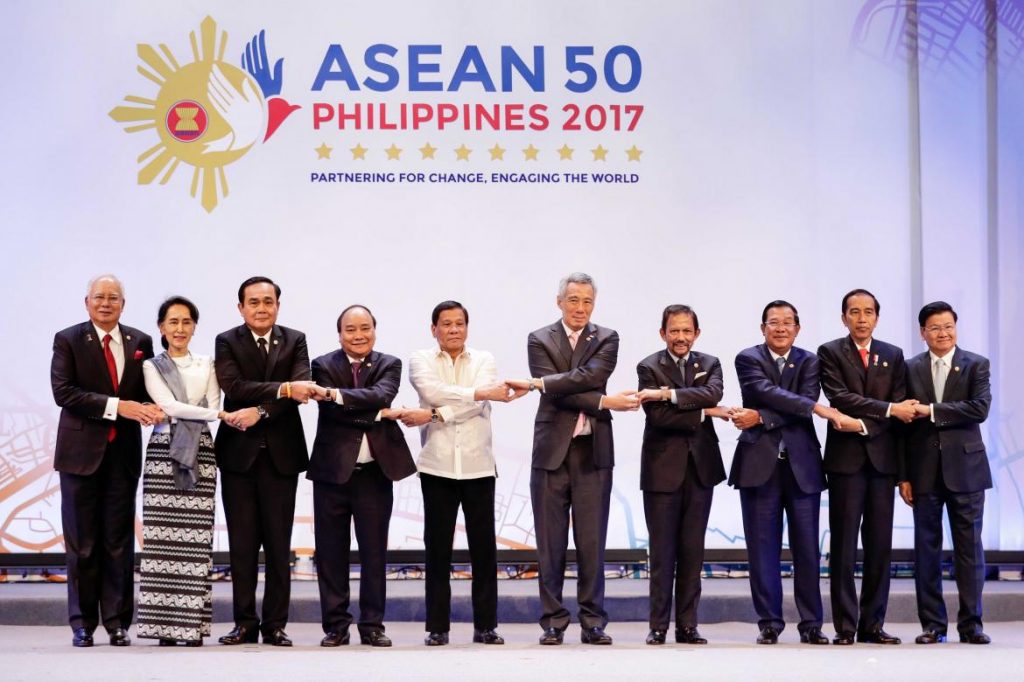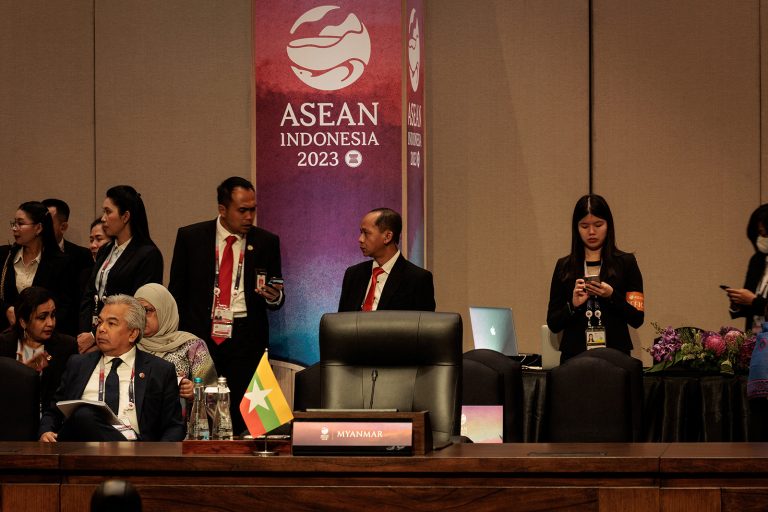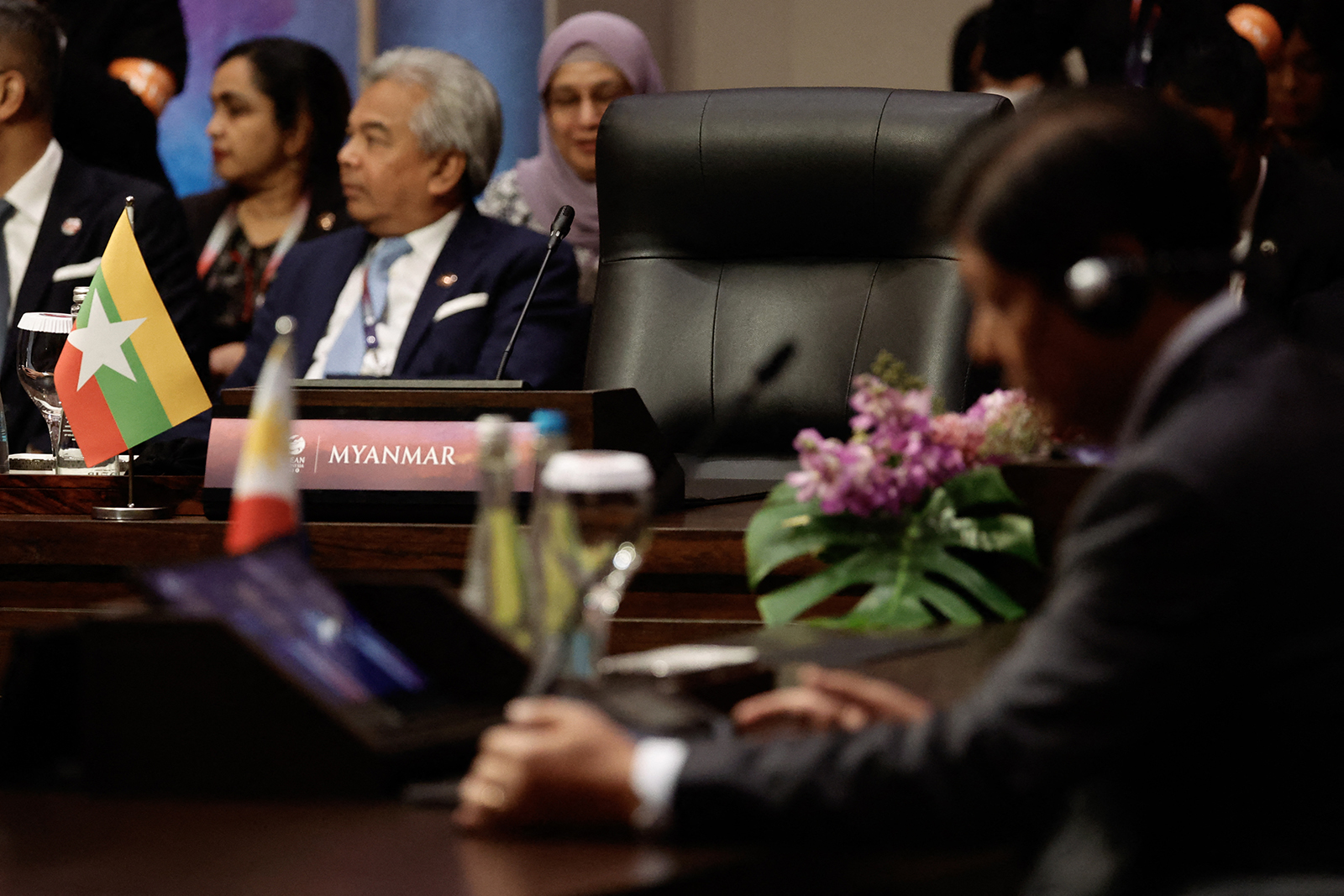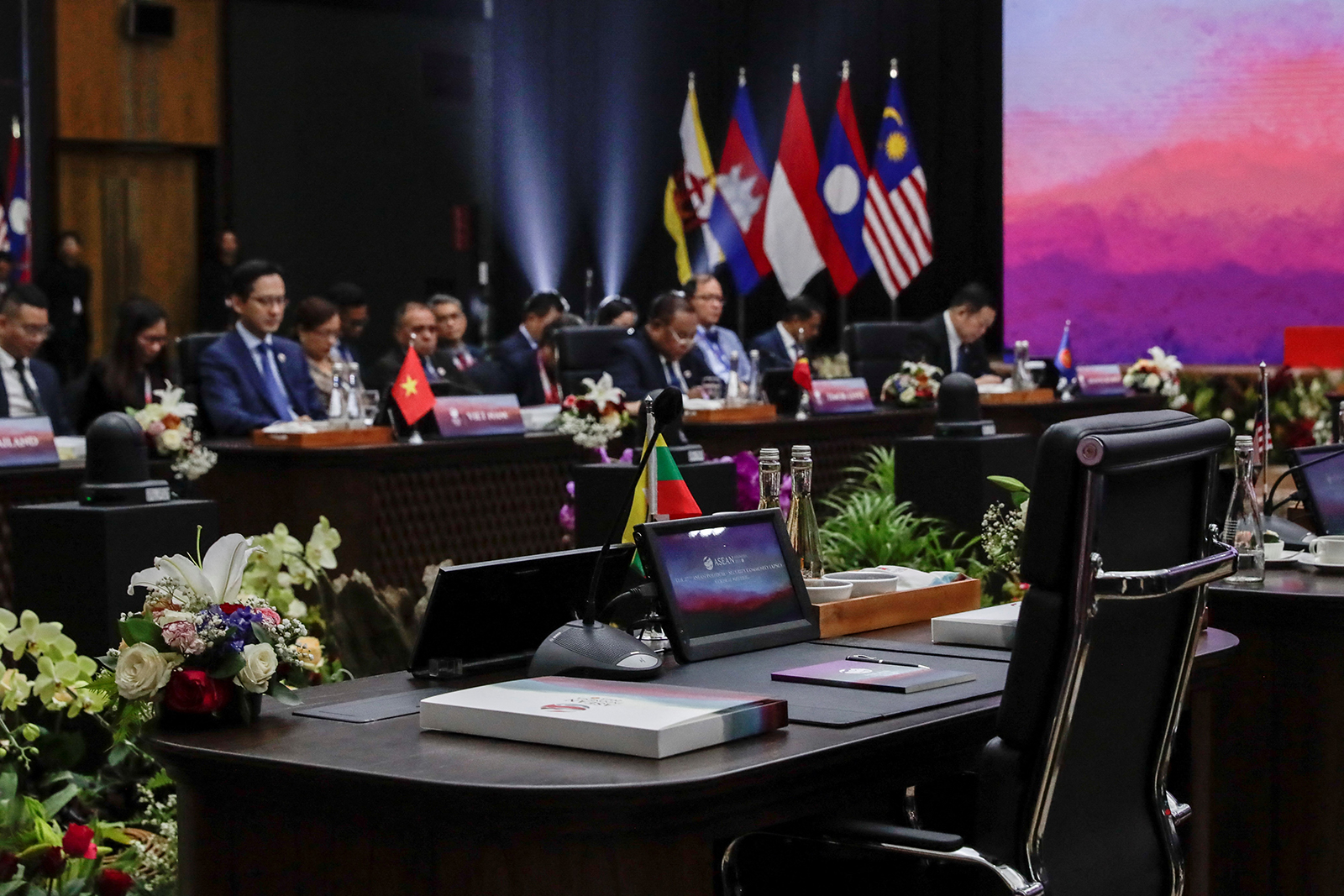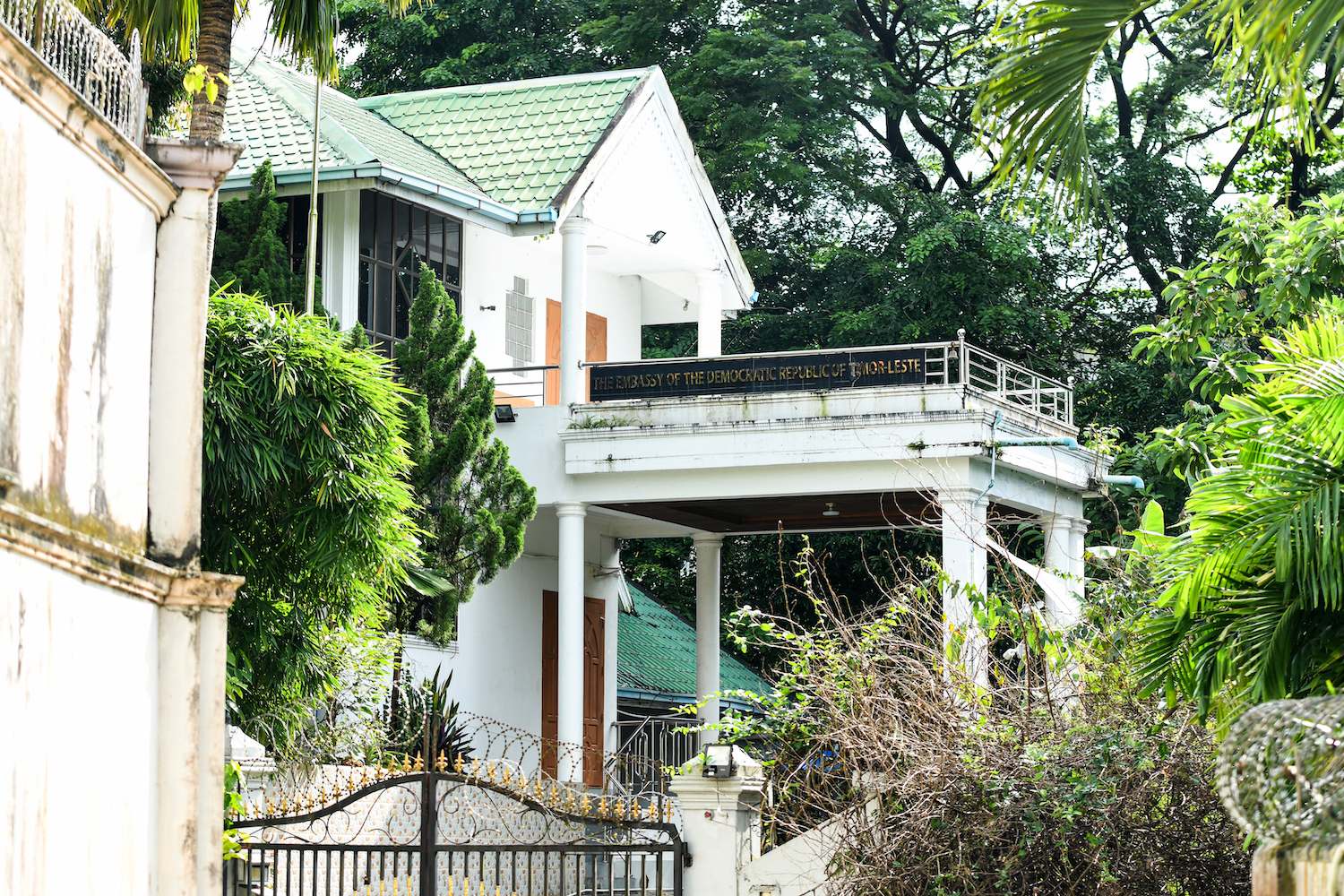A former ASEAN secretary general offers a personal perspective on how the bloc needs to change in order to build on the achievements of its first 50 years.
By SURIN PITSUWAN | FRONTIER
THE Association of Southeast Asian Nations celebrates its 50th anniversary this year and can be proud of its considerable achievements. It has developed a region-wide platform that serves as a mechanism for consultation and reconciliation to avoid flashpoints from deteriorating into possible confrontation. Through ASEAN, major powers that have a direct interest in the stability and peace of the region can become involved in discussion and dialogue.
Over half of ASEAN’s 620 million people are now enjoying “middle class” status, and the bloc boasts a total GDP of US$2.5 trillion, rising purchasing power and sustainable growth. Members are integrated into production networks for many industries that have relocated from around the world, but they have also become lucrative markets for imported consumer goods in their own right. Their combined trade volume has reached $2.6 trillion while foreign direct investment has been hovering around $130-150 billion a year for some time.
As ASEAN continues to strive towards greater integration through the political, economic, social and cultural goals of the ASEAN Community, global and regional changes will create new pressures and strains for ASEAN and its ability to achieve those goals. Global power plays both within and outside the region will inevitably play out on the ASEAN stage.
The challenge is whether ASEAN is willing, capable and ready to play a larger role. To deal with the new stresses, strains and pressures, the regional grouping will need to enhance its capacity, streamline its decision-making processes, reconfigure its working processes and adopt a new mindset for pro-active engagement from the passive “ASEAN Way” of the past 50 years.
Support more independent journalism like this. Sign up to be a Frontier member.
Unlike the past 50 years, there is now a growing sentiment against globalisation and multilateralism. In the past, emerging economies were opposed to globalisation for fear of domination and dependency by more developed countries and economies. But over time, ASEAN states learned to adapt and eventually benefited from waves of globalisation, in the form of open trade, free flow of investment, relocation of manufacturing, effective transfer of technology and human resource development.
Recently though we’ve seen attempts to rewrite the rules of the game. There has been a withdrawal from commitments on global trade deals and pulling back of investment to Western economies. We can see rising protectionist trends and an emphasis on “my country first”. These trends are potentially damaging to the ASEAN approach of welcoming and accommodating trade and foreign investment. FDI is likely to shrink, markets are showing signs of fatigue for foreign goods, and the global goodwill for all things ASEAN seems to have reached its limit.
ASEAN finds itself sandwiched between the changing roles of the United States and China. There is now an unmistakable sign from the United States, a major dialogue partner, that the rules of the game have shifted and preference will be given to bilateral dealings. Major powers will pick and choose when to engage with ASEAN as a group, or each member state individually. This will be a formidable challenge to the future of ASEAN – and may even be an existential challenge.
In the years prior to the recent shift from the US, a more assertive China was undermining the basic assumption that ASEAN has always been unified on external relations. In the late ’90s and early 2000s, China was courting ASEAN’s trust and goodwill. ASEAN reciprocated with its own olive branch, welcoming the rise of a peaceful China. Maritime disputes with some ASEAN member states were kept under wraps; economic relations developed in leaps and bounds.
China has become the second-largest economy in the world and all ASEAN countries have become dependent on the China market. Having replaced the European Union, Japan and the US as the bloc’s largest trading partner, China has now chosen to reconfigure its relations with its southern neighbors. ASEAN’s agenda has been frustrated, its normal practices have been altered and its traditional solidarity has been undermined. On top of this rapidly changing global landscape, ASEAN faces fierce competition from other emerging economies. India, China, and countries in Africa and Latin have been drawing foreign investment away from the region in the past several years and the trend will continue.
What must ASEAN do so that it can face these challenges and survive the competition?
First and foremost, it must deliver on the commitments it has agreed among its member countries. ASEAN has taken pride in having established most of the legal instruments it set out to create under the ASEAN Charter of 2007 and the blueprints to make the ASEAN Community a reality. What is lacking is the will to implement those instruments at the national level. In the past we made do with accommodation and collegial compromises. This form of procrastination and evading responsibility will not work in the future. The global community needs to see the delivery on the promise.
Of the three pillars, economic integration and making the region an attractive destination for investment under the blueprint for the ASEAN Economic Community is the most daunting to achieve. Connectivity is crucial, and ASEAN has been embarking on a Connectivity Plan in order to facilitate the transport of goods and people across Southeast Asia, As the need for infrastructure financing increases, ASEAN will have to mobilise its collective resources.

China’s President Xi Jinping and US President Donald Trump attend a working session on the first day of the G20 summit in Hamburg, Germany, on July 7. (AFP)
The combined foreign exchange reserves of all the ASEAN member states – a sum exceeding $1 trillion – could be utilised more creatively. If the member states want to show their commitment to the much-touted ASEAN Community, a mere 10 percent of the combined reserves would go a long way in bridging the funding gap that now exists in the Connectivity Plan. This could be in the form of concessionary loans. Much could be achieved if each country agreed to put a portion of its foreign exchange reserve into a fund for a trusted Asian Development Bank to manage. There is no risk involved but potentially much to be gained, and ASEAN would be less dependent on external sources of funding for connectivity and infrastructure development.
ASEAN also needs to combat the growing tide against globalisation and multilateralism. For this, the region has to rely on itself. This is why expanded regional economic integration with other large economies – those close to us geographically, and important to our success and survival – must become a priority. The Regional Comprehensive Economic Partnership with six regional trading partners, namely, China, Japan, South Korea, India, Australia and New Zealand, must be concluded urgently. We are talking about turning existing bilateral trade agreements with these countries into one trade bloc. There is no more time for delay or procrastination. It is a matter of survival.
There is an urgent need for solidarity in ASEAN’s posturing towards external partners. Whether in strategic and security matters, trade negotiations, or other issues on the global agenda, ASEAN needs a more common and solid front. If ASEAN is unable to develop a strong common stand, it will succumb to strategic power plays. The grouping will lose all the global trust and confidence it has carefully cultivated over the past five decades. There is a common desire for ASEAN to develop and present one united response to the myriad global issues and challenges. There is an urgency to put that into practice now.
ASEAN should also rethink its definition of the “security and strategic interest of ASEAN” and broaden it to reflect changes in the global arena. The grouping has been enjoying its leadership role in the consultative processes of the Asia-Indo-Pacific larger region. The East Asia Summit (EAS), born in 2005, with ASEAN plus six as participants, has been billed as “the leader-led political, security and strategic platform” of the region.

typeof=
The US and Russia have been included in the EAS since 2010, but the EU has been kept at arms-length because the EU has “no geographical presence nor the capacity or the desire for force projection” into the region and therefore does not qualify for membership. The fact is though that the EU has been a major force for trade and investment into ASEAN for many years and has been one of the region’s top trading partners for the past couple of decades. ASEAN should reconsider the issue of granting the EU a seat at the EAS.
Last but not least, under the charter ASEAN promises to be a “people-oriented organisation” with adherence to the principles of democracy and the respect for human rights. So far ASEAN has been driven by the leaders and the diplomats, drawing bargaining power from the profile of the regional grouping. As each country has gone through its own evolution and transformation, more people from all levels of their societies would want to take part and contribute more to the future course of this regional body.
People will find out sooner or later that some member states are benefiting more than others from the Community. And for certain member states to benefit more, it will require them to initiate reforms in political governance and economic management. Without such reforms – and some of them will be painful – inequity among member states will remain. This will lead to the demand for change and reform at the national level, something that would be best managed by a more open, democratic system. Many of the ASEAN member states are still resisting this imperative of change building up from the grassroots levels of all countries.
There is no doubt that much has been accomplished in the past 50 years but so much more needs to be done. The second half of the first century of ASEAN will require the full ownership, the active participation and the meaningful contributions of all its people. Since its inception, ASEAN has been the product of a “collective will” and a common aspiration of the people. It was meant to be a democratic construct. The next generation of leadership cannot deviate from that sacred path of the first 50 years.
Myanmar ‘an investment in the future’ for ASEAN
Myanmar has been a member of ASEAN for exactly two decades out of ASEAN’s 50 years of existence. When Myanmar was admitted into the regional grouping in Kuala Lumpur in July 1997, the Asian Financial Crisis was in full swing. Dr Mahathir Mohamad’s decision to welcome the military-run country was seen as another act of defiance against the wishes of Western dialogue partners.
Yet ASEAN took a collective decision as “a future investment” in a country linking the two emerging economic giants of Asia: China and India. For the next decade and a half, until the U Thein Sein government began initiating reforms in 2011-12, ASEAN came under pressure from most of its dialogue partners because of the political situation in Myanmar. But ASEAN stood firm in support of the country’s “road map” to democracy.
ASEAN poured its heart out to Myanmar when Cyclone Nargis descended on the Ayeyarwady Delta in early May 2008. Almost 140,000 perished in the high tides and ferocious floods in the dark hours of May 3 and for weeks the country refused to open up to international aid. ASEAN was able to negotiate an opening with the military junta and also convince the world to drop all conditions of sanctions against Myanmar in order to protect a large portion of Myanmar’s population from disease and famine, and rehabilitate the devastated delta.
ASEAN took the lead and engaged the international community in the reconstruction efforts for two-and-a-half years. To many observers, ASEAN’s humanitarian engagement contributed to the confidence with which Myanmar subsequently opened up to the world after the 2010 election.
Older member states have the potential to benefit enormously from Myanmar’s economic growth. It’s a resource-rich and relatively large country, and a potential market of over 50million consumers that has just emerged from decades of hibernation. But for Myanmar to earn the trust and confidence of economic partners from ASEAN and further afield, it will require effective national integration, a compassionate and inclusive political structure, a higher level of efficiency of governance, and transparent economic management. Myanmar will also need policy stability, the rule of law and a credible reform agenda to fully attract foreign investment if it is to travel a similar economic development path to the older ASEAN member states.
The strategic location of Myanmar between two giant neighbours offers a strategic opportunity for the rest of ASEAN, too. If Myanmar plays its hand right, connectivity through Myanmar for China going west and for India looking east would enhance both its geo-strategic value and economic advantage.
The success of Myanmar in this balancing act would also contribute to ASEAN’s own political and economic successes in tapping the dynamism of the world’s two largest emerging economies. In this sense, Myanmar is the front line state for ASEAN in its delicate dealings with these giant neighbours.
Myanmar continues to be “an investment in the future” for the rest of ASEAN. The prospects are quite encouraging indeed, but only Myanmar can make that investment a win-win situation for all.
TOP PHOTO: ASEAN leaders, including Daw Aung San Suu Kyi, join hands as they pose for a photo during the opening cermeony of a leaders’ summit in Manila on April 29. (AFP)


